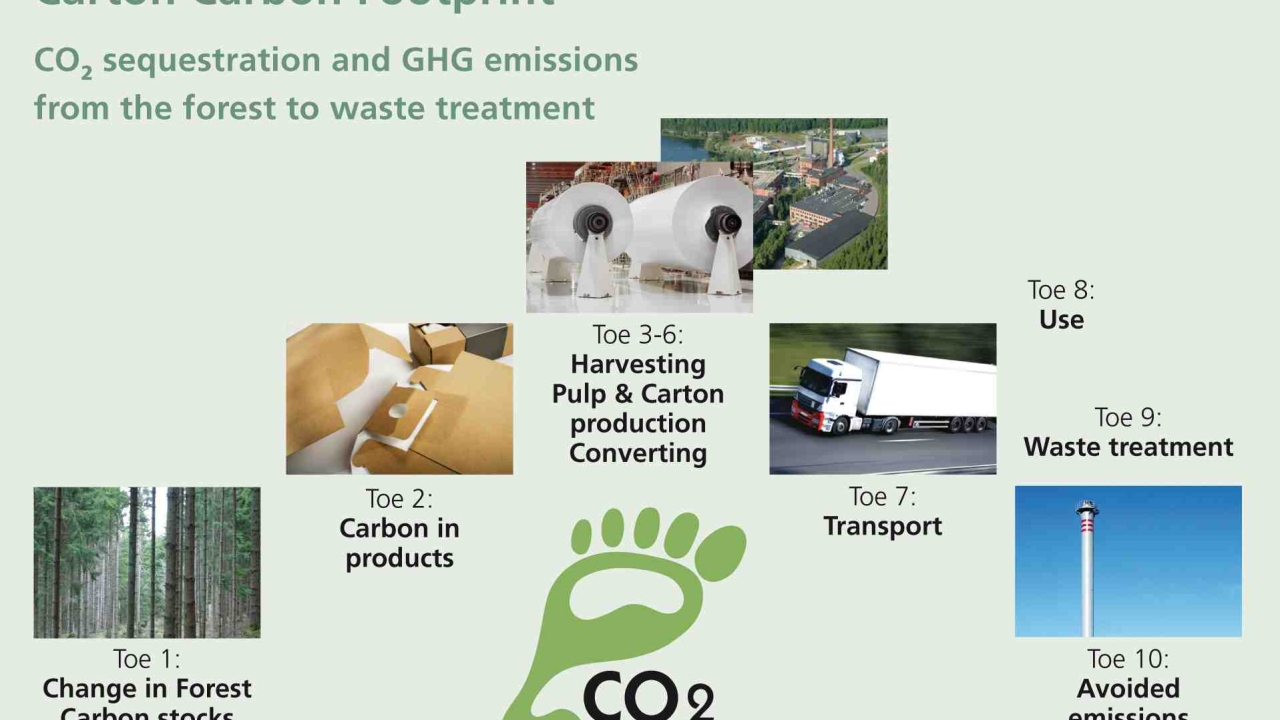Cartons and Carbon Footprint

Jennifer Buhaenko, Head of Public Affairs at Pro Carton, outlines the case for natural fibre packaging.
Recent surveys show that carbon footprinting and ease of recycling are considered the most important issues when measuring the environmental impact of packaging. Paper and board packaging, with a well established recovery and recycling structure, also has a good environmental story to tell when it comes to carbon footprints.
There is currently no agreed way to calculate a Carbon Footprint, so in the meantime, the paper and board industry has developed an approach for paper based products known as the CEPI Framework. Its development was overseen by the industry’s umbrella organisation, the Confederation of Paper Industries.
The CEPI Framework consists of 10 areas (known as Ten Toes), which form the boundaries for a cradle to grave life cycle analysis:
Toes 1 and 2 deal with the raw material from the forest and looks at Forest Carbon Stocks and carbon in the product.
Toes 3 to 7 deal with fossil emissions from the production process - the industry has calculated the average carbon footprint of all carton production in Europe as 964 kg of carbon dioxide (and equivalents) for each tonne of cartonboard converted. The carbon footprint for cartons has reduced by 7% in 3 years.
Toes 8, 9 and 10, deal with use of the product, waste treatment and avoided emissions – these occur after the exit door of the carton converter and are less easy for the industry to measure. For Toe 8, the Use phase, the result is 0, since no external energy is required to open and use a carton. For Toes 9 and 10, national or European averages are often used.
The forest products industries, including the cartonboard packaging industry, have a unique attribute to bring to the Carbon Footprinting discussion: the properties of their renewable raw material – wood fibre from sustainably managed forests.
European forests used by the paper and board industry are sustainable, since every year, new growth exceeds the wood harvested by up to 45%. Forests offer a natural habitat to vast numbers of different species of plants and animals and management of the forest for timber production and leisure activities provides economic benefit to the owners and local communities. Around 80% of the wood used to make paper and board in Europe, comes from European forests, with the remainder coming from outside the EU. No tropical rainforest wood is used.
Trees absorb and store carbon and this can be measured in terms of biogenic carbon. When the wood fibre is processed into cartons, the carbon continues to be stored in the cartons. When cartons are recycled, and used to make other papers or packaging, the carbon is locked up even longer.
In the CEPI Framework, the attributes of the raw material are taken into account in Toe 1 (Forest Carbon Stocks). To see if we could measure this benefit and give a value to Toe 1, Pro Carton supported its partner association ECMA (European Carton Makers Association) in a study by IVL, Swedish Environmental Research Institute, into the link between biogenic carbon and cartons.
IVL’s study suggests a link between carton consumption and carbon uptake and storage in the forest, as follows:
- Sustainable forest management is essential for high carbon sequestration (absorption and storage) in the forest, since actively managed forests remove carbon from the atmosphere at a much higher rate than non-managed forests
- There is a beneficial link between the market’s demand for cartons and carbon sequestration, which is illustrated in the chart
- Net carbon sequestration in the forest (removals from the atmosphere) for the average of all carton production in Europe, amounts to -730 kg of biogenic carbon per tonne of cartons
While this question is by no means settled, Pro Carton believes that cartons should be credited for the carbon sequestration of their raw material when cartons’ carbon footprints are calculated. Toe 1 should be brought into the equation.

If biogenic carbon associated with its raw material, were to be credited against carbon dioxide emitted during the carton’s life cycle, deducting the biogenic carbon removed from the atmosphere from the fossil carbon emitted would result in a very low carbon footprint:
Cradle to gate: 234 kg CO₂ / tonne
Cradle to grave: 397 kg CO₂ / tonne
If you would like more information, please logon to
Stay up to date
Subscribe to the free Label News newsletter and receive the latest content every week. We'll never share your email address.

